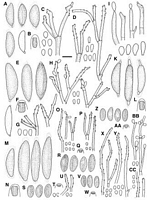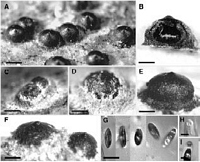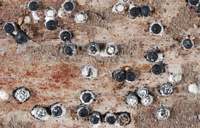|
 Rosellinia rhopalostylidicola Rosellinia rhopalostylidicola
BiostatusPresent in region - Indigenous. Endemic
Images (click to enlarge)
Caption: Fig. 12 A-D, Rosellinia novae-zelandiae, PDD 43205: A, Ascospores, last one immature; B,
Ascus apical ring; C, Conidiophores and conidia on the host (PDD 16422); D, Conidiophores
and conidia in culture (PDD 42074); E-H< | 
Caption: Fig. 26 Rosellinia rhopalostilicola. A, C-F,
Stromata, C, D, F, showing subiculum; B,
Vertical section of stroma; G, Ascospores, 2nd showing germ slit; 
Caption: On fallen nikau fronds, Piha, June 2008
Owner: Herb PDD | |
Article: Petrini, L.E. (2003). Rosellinia and related genera in New Zealand. New Zealand Journal of Botany 41(1): 71-138 (http://www.rsnz.org/publish/abstracts.php).
Description: Subiculum evanescent, restricted in extension approx. 2-6 x 1-2 mm, in white, cream, to light
brown patches, bearing conidiophores, covering stromatal initials, subsequently reduced while
stromata progressively emerge and eventually confined to stromatal margins until absent in
old material. Stromata (225)507 ± 112(825) µm high, (375)628 ± 107(875) µm wide (n = 60),
semiglobose, cupulate to conical, black, smooth, shiny, adhering to the substrate with a flat
ring composed of hard stromatic material, solitary or in small groups on a common stromatic
layer, occasionally containing more than one perithecium. Young stromata covered by a cream
to light brown to grey, felty, hyphal mat, progressively emerging during development until
completely free at maturity. Ostioles finely papillate, sometimes minimally pronounced.
Ectostroma 25-50 µm thick, hard, splintering. Entostroma not seen. Perithecia detached and
collapsed in older material, located in the centre of cavity. Ascus apical rings (1.9)2.3 ±
0.4(2.8) long, upper width 2-3.6 µm, lower width 1.5-2 µm (n = 26), without bulge at upper
margin, J+, pale blue. Ascospores (10.5)13 ± 0.8(15.4) µm long, (4.3)6 ± 0.5(10.5) wide (n =
290), ellipsoidal, brown, with straight germ slit extending the whole spore length or ending
shortly before. Conidia 3.5- 5.5 x 2.5-3.5 µm.
Cultures on OA after 33 days at 20°C under 12 h dark and 12 h UV and fluorescent light
(2.5)6- 6.5 cm diam., velvety from short hyphae, dense, felty, white to tan, light grey in the
centre, restricted grey pustules with conidiophores. Conidiophores up to 200 µm long, 3 µm
wide, mononematous, macronematous, erect, irregularly dichotomously branched, smooth,
pale tan. Conidiogenous cells 9- 28 x 3 µm (n = 28), terminal or integrated, cylindrical,
geniculate with circular refractive frill,1 µm diam., at each point of conidial dehiscence.
Conidia (2.5)3-5 x 2-3(4) µm (n = 44), subglobose to obovate, with flat, protuberant, c. 1 µm
wide base bearing a refractive ring, smooth, subhyaline to pale tan. On CMD after 21 days
under same conditions 2 cm diam., transparent, light grey-tan, with erect, short, much
branched aerial hyphae, conidial production poor, restricted to few scattered tufts.
Conidiophores variable in length, more than 150 µm, repeatedly branched, without main axis,
smooth, subhyaline to pale tan. Conidiogenous cells variable in length, 2-3 µm wide,
cylindrical, geniculate terminal, rarely intercalary with circular refractive frill at each point of
conidial dehiscence. Conidia 3.5-5 x 2.5-3.5 µm (n = 22), subglobose to clavate, with flat,
protuberant, base bearing a refractive ring, smooth, subhyaline to pale tan.
ANAMORPH: Geniculosporium.
Habitat: HOSTS: Rhopalostylis sapida.
MATRIX: Pieces of rachides.
Notes: ETYMOLOGY: Referring to the most frequent host, Rhopalostylis.
NOTES: Rosellinia rhopalostilicola has black, shiny stromata covered by a cream to light
brown subiculum when young. It differs from R. johnstonii by apically rounded stromata,
larger ascospores, and a symmetrical germ slit; from R. mammoidea by cupulate stromata with
more pronounced ostioles, ascospores without a cellular appendage, and a germ slit extending
the whole spore length; and from R. communis by stromatal shape and much smaller
ascospores. It can be distinguished from R. subiculata by the subiculum colour and larger
ascospores (Petrini 1993).
The presence of a subiculum in young stages as well as the Geniculosporium anamorph justify
placement of this species in Rosellinia. Mature specimens without subiculum might be
confused with Astrocystis spp. at first sight, because they occur on palm and most species of
Astrocystis are described from such hosts (Smith & Hyde 2001). The stromata of R.
rhopalostilicola, however, show the regular nearly cupulate shape of typical Rosellinia and
have well-pronounced papillate ostioles and the surface is smooth and shiny, without traces of
a splitted stroma or adhering host material. Rosellinia euterpes Rehm, also described from a
palm, has wider, semiglobose, opaque stromata with less pronounced ostioles, smaller ascus
apical rings and smaller ascospores than R. rhopalostilicola
|